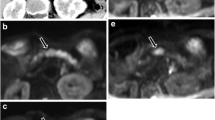Abstract
The aim of this work was to assess the diagnostic value of fast steady state free precession (SSFP) for the detection, characterization, and delineation of pancreatic lesions. Forty-eight patients referred for magnetic resonance (MR) imaging of the pancreas were included in the study. In addition to the standard protocol, axial pre-contrast SSFP slices of the pancreas were acquired. The standard of reference was defined as based on all imaging data other than SSFP, histopathology, surgery, and/or clinical follow-up. A randomized consensus reading of the SSFP data sets was retrospectively conducted by two board-certified radiologists. The presence of pancreatic lesions, local infiltration, and lymph node metastases was evaluated. Sensitivity and specificity were calculated and a receiver operating characteristic (ROC) analysis was performed. The overall sensitivity and specificity of SSFP were 0.93 and 0.77, respectively. Comparable values were achieved for lymph node detection (0.88/0.91) and assessment of vascular infiltration (0.94/0.91). The mean area under the ROC curve (Az) was 0.91. Owing to its potential to detect vascular infiltration and the rapid acquisition time, SSFP imaging should be supplemented as part of a standard MR protocol of the pancreas.





Similar content being viewed by others
References
Semelka RC, Kelekis NL, Molina PL, Sharp TJ, Calvo B (1996) Pancreatic masses with inconclusive findings on spiral CT: is there a role for MRI? J Magn Reson Imaging 6:585–588
Pavone P, Laghi A, Catalano C, Panebianco V, Fabiano S, Passariello R (1999) MRI of the biliary and pancreatic ducts. Eur Radiol 9:1513–1522
Robinson PA (2002) The role of MRI in pancreatic cancer. Eur Radiol 12:267–269
Kalra MK, Maher MM, Mueller PR, Saini S (2003) State-of-the-art imaging of pancreatic neoplasms. Br J Radiol 76:857–865
Hammond N, Miller FH, Sica GT, Gore RM (2002) Imaging of cystic diseases of the pancreas. Radiol Clin North Am 40:1243–1262
Gabata T, Matsui O, Kadoya M et al (1994) Small pancreatic adenocarcinomas: efficacy of MR imaging with fat suppression and gadolinium enhancement. Radiology 193:683–688
Gohde SC, Toth J, Krestin GP, Debatin JF (1997) Dynamic contrast-enhanced FMPSPGR of the pancreas: impact on diagnostic performance. Am J Roentgenol 168:689–696
Mitchell DG, Outwater EK, Vinitski S (1994) Hybrid RARE: implementations for abdominal MR imaging. J Magn Reson Imaging 4:109–117
Outwater EK, Mitchell DG, Vinitski S (1994) Abdominal MR imaging: evaluation of a fast spin-echo sequence. Radiology 190:425–429
Semelka RC, Kelekis NL, Thomasson D, Brown MA, Laub GA (1996) HASTE MR imaging: description of technique and preliminary results in the abdomen. J Magn Reson Imaging 6:698–699
Fuchs F, Laub G, Othomo K (2003) TrueFISP—technical considerations and cardiovascular applications. Eur J Radiol 46:28–32
Scheffler K, Lehnhardt S (2003) Principles and applications of balanced SSFP techniques. Eur Radiol 13:2409–2418
Semelka RC, Balci NC, Op de Beeck B, Reinhold C (1999) Evaluation of a 10-minute comprehensive MR imaging examination of the upper abdomen. Radiology 211:189–195
Fischer U, Vosshenrich R, Horstmann O et al (2002) Preoperative local MRI-staging of patients with a suspected pancreatic mass. Eur Radiol 12:296–303
Pruessmann KP, Weiger M, Scheidegger MB, Boesiger P (1999) SENSE: sensitivity encoding for fast MRI. Magn Reson Med 42:952–962
Jeong YY, Mitchell DG, Holland GA (2001) Liver lesion conspicuity: T2-weighted breath-hold fast spin-echo MR imaging before and after gadolinium enhancement—initial experience. Radiology 219:455–460
Jung B, Krombach GA, Gunther RW, Buecker A (2004) Is postcontrast trueFISP imaging advantageous? Invest Radiol 39:517–523
Piironen A, Kivisaari R, Laippala P, Poutanen VP, Kivisaari L (2001) Pancreatic carcinoma and fast MR imaging: technical considerations for signal intensity difference measurements. Eur J Radiol 38:137–145
Author information
Authors and Affiliations
Corresponding author
Rights and permissions
About this article
Cite this article
Herborn, C.U., Vogt, F.M., Lauenstein, T.C. et al. Evaluation of steady state free precession imaging of the pancreas. Eur Radiol 15, 1629–1633 (2005). https://doi.org/10.1007/s00330-005-2774-1
Received:
Revised:
Accepted:
Published:
Issue Date:
DOI: https://doi.org/10.1007/s00330-005-2774-1




